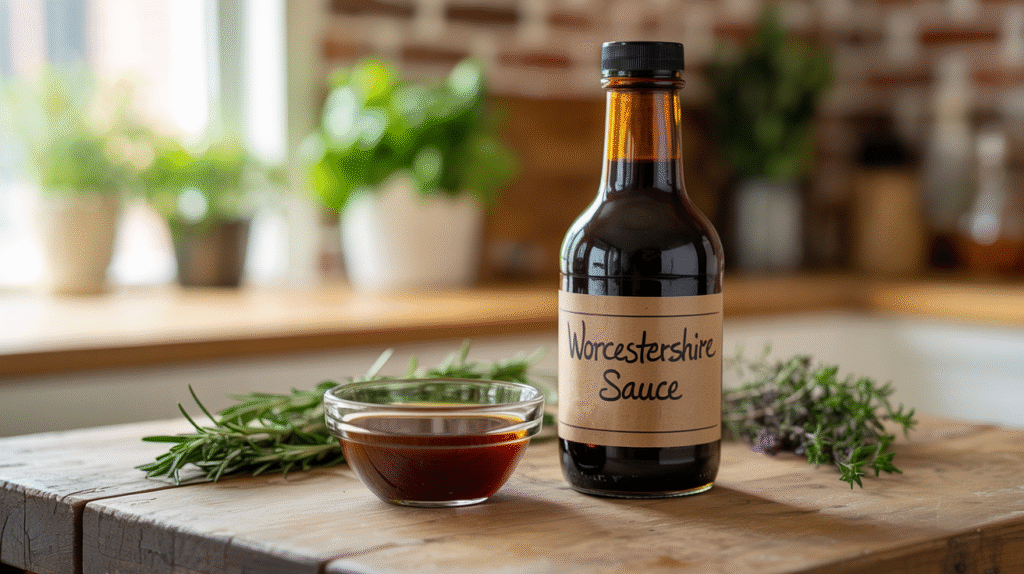Affiliate Disclosure: PantryBrands.co.uk is a participant in the Amazon.co.uk Associates Programme. As an Amazon Associate, we earn from qualifying purchases made through links on this site.
Worcestershire sauce is a fermented condiment with a complex flavour profile combining tangy, savoury, sweet, and umami notes. Originating in Worcester, England in the 19th century, it’s now a staple in kitchens worldwide, used in everything from marinades to cocktails. This guide explores its uses, nutrition, varieties, and how to choose the best bottle.

Worcestershire Sauce Culinary Uses
Worcestershire sauce is far more versatile than many people realise.
- Meat Marinades – Enhances beef, pork, or chicken with depth and umami.
- Stews & Casseroles – Adds richness to slow-cooked dishes.
- Bloody Mary Cocktails – A classic ingredient for a spicy kick.
- Cheese on Toast – A dash before grilling elevates flavour.
Worcestershire Sauce Health Points
While rich in flavour, it’s important to consider its nutritional aspects.
- Calories – About 10–15 kcal per tablespoon (15ml).
- Sodium – Around 150–200mg per tablespoon, lower than soy sauce but still significant.
- Micronutrients – Contains small amounts of vitamin B6 and minerals from anchovies and molasses.
- Fermented Benefits – Traditional fermentation may aid flavour complexity but offers minimal probiotic benefit after pasteurisation.
Tip: Vegan versions are available for those avoiding anchovies.
Classic UK Worcestershire Brands
Several brands dominate UK shelves, each with its own taste.
- Lea & Perrins – The original, with a balance of sweet, tangy, and umami notes.
- Tesco & Sainsbury’s Own-Brand – Affordable with a milder flavour.
- Stokes – Premium small-batch with natural ingredients.
- Asda Extra Special – Richer and slightly sweeter.
Worcestershire Sauce vs Fish Sauce
Though both add umami, they are distinct condiments.
- Worcestershire Sauce – Blended, fermented, with tang, sweetness, and spice.
- Fish Sauce – Straight fermented fish extract, saltier and more pungent.
When to Choose: Worcestershire for Western-style dishes and marinades, fish sauce for authentic Southeast Asian recipes.
Homemade Vegan Worcestershire Sauce
You can make a plant-based version at home without anchovies.
Basic Method:
- Combine soy sauce, apple cider vinegar, molasses, and tamarind paste.
- Add garlic, onion powder, cloves, and a pinch of chilli.
- Simmer and cool before storing.
Storage: Keep refrigerated for up to 1 month.
Varieties of Worcestershire Sauce
Different recipes cater to various dietary and taste preferences.
- Classic – Anchovy-based, fermented.
- Vegan – Anchovy-free, plant-based umami sources.
- Low-Sodium – Reduced salt for dietary needs.
- Gluten-Free – Made with gluten-free soy sauce or tamari.
Worcestershire Sauce Ingredient Guide
A traditional Worcestershire sauce typically contains:
- Vinegar – For acidity and preservation.
- Molasses – Adds sweetness and depth.
- Anchovies – Umami source (absent in vegan versions).
- Tamarind – Tangy fruit for balance.
- Spices – Cloves, chilli, and garlic.
Worcestershire Sauce Nutrition Facts
The nutritional breakdown per tablespoon (15ml) typically includes:
- Calories – ~10–15 kcal.
- Sodium – ~150–200mg.
- Carbohydrates – 2–3g, mostly from sugar/molasses.
Storage Tips for Worcestershire Sauce
Proper storage ensures flavour longevity.
- Unopened – Store in a cool, dark place for up to 3 years.
- Opened – Can be stored at room temperature, but refrigeration extends freshness.
Shopping for Authentic Worcestershire Sauce
Look for these signs of quality:
- Brand Heritage – Original recipes often have more balanced flavour.
- Ingredient Simplicity – Fewer artificial additives means better taste.
- Fermentation Time – Longer fermentation tends to produce richer flavour.
FAQs about Worcestershire Sauce
Here are some questions and answers about Worcestershire sauce.
Is Worcestershire sauce vegan?
Traditional versions are not, due to anchovies, but vegan alternatives are available.
Can Worcestershire sauce be used instead of soy sauce?
It can in some recipes, but expect a tangier and sweeter result.
Does Worcestershire sauce need refrigeration?
It can be stored in the cupboard, but refrigeration helps preserve its flavour for longer.
